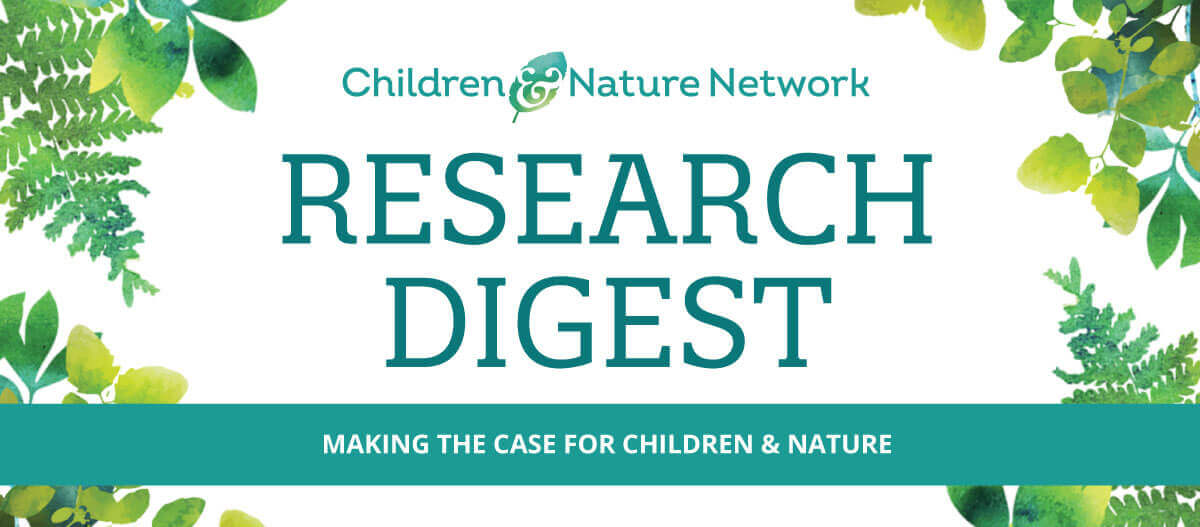1. Use different forms of nature-related technology in educational settings to promote engagement with learning
Integrating natural and digital experiences can support self-directed learning
Researchers in Sweden explored how two elementary students, ages 6-7, simultaneously used technology and nature to explore ecological interactions. Students incorporated an iPad as they learned about ecological concepts, a process that blurred the distinction between natural and digital. Through students’ self-directed learning processes, the digital tablet was an important resource that supported their developing eco-literacy and agency.
Caiman & Kjällander, 2024. Elementary students’ ‘outdoor – digital’ explorations in ecology – learning through chains of transduction.
Access Study
Virtual reality nature, when combined with physical activity, improves young children’s attention
Researchers investigated the effects of virtual reality (VR) nature videos and physical movement on young children’s attention. Participants included 152 kindergarteners, ages 4-6, in China who were randomly assigned to groups experiencing different combinations of nature VR and physical activity. Analysis of pre- and post-test attention scores revealed significant improvements to auditory and visual attention for students who viewed VR nature after a short period of physical activity.
Luo et al., 2023. The effect of different combinations of physical activity and natural environment videos on children’s attention levels between class breaks.
Access Study
Technology supports education for sustainable development through global partnerships
This study aimed to identify the learning outcomes prioritized by Virtual School Garden Exchange (VSGE) educators worldwide. VSGEs are technology-based international school partnerships focused on gardening. In interviews, 27 VSGE educators from Europe, Africa, and the Americas highlighted the aim of fostering knowledge regarding gardening, the global importance of gardening, as well as global challenges such as climate change.
Lochner, 2021. Educators’ intentions for learning in virtual school garden exchanges: A comparison with the aims of education for sustainable development.
Access Study
Kindergarten children using iPads showed enhanced engagement with learning both outdoors and indoors
In this study, kindergarten students in Canada used digital technology in the outdoors over the course of three school years. The study showed numerous benefits to the students, based on teacher feedback and computer-generated artifacts created by the students. The apps used by the children allowed them to document different aspects of the natural environment, capture their personal interests in nature, and express their feelings about nature. Additional benefits included enhanced physical and creative play, and deeper engagement in learning activities.
McGlynn-Stewart, Maguire & Mogyorodi, 2020. Taking it outside: Engaging in active, creative, outdoor play with digital technology.
Access Study
Balancing technology and outdoor learning can enhance early childhood education
This paper provides a research-based overview of the cognitive, social-emotional and academic benefits of both technology and outdoor learning for young children. It also offers recommendations for how early childhood teacher educators can integrate the two in developmentally appropriate ways. Risks related to children’s use of technology are also reviewed.
Siskind et al., 2020. Balancing technology and outdoor learning: Implications for early childhood teacher educators.
Access Study




 Researchers scraped data from over 101,000 school websites to discover the common characteristics of outdoor learning in U.S. elementary and secondary schools. Learn more at “Mapping the Landscape,” one of many eye-opening sessions at the upcoming Nature Everywhere Conference, May 28-31 in Madison, Wisconsin.
Researchers scraped data from over 101,000 school websites to discover the common characteristics of outdoor learning in U.S. elementary and secondary schools. Learn more at “Mapping the Landscape,” one of many eye-opening sessions at the upcoming Nature Everywhere Conference, May 28-31 in Madison, Wisconsin.
